DL-2300
| YONGMEI
DL-2300 |
stinking sample based tablehooter with programmable rhythm & cute electronic accompaniment |
Despite Yongmei's transistor tooter age is over (see Golden Camel 7A), they still makes the definitely worst built keyboards I ever saw! While the concept and operation of this sample based fullsize tablehooter already resembles any normal modern sound bank keyboard, 2 severe flaws make it almost unusual - when new it stinks unbearable acrid and it can be played only monophonic due to omitted key matrix diodes. It also has only each 20 instead of pretended 100 preset sounds and rhythms because the rest is simply identical to fraud customers. But the cute pseudo- analogue accompaniments are lovely.
I also really don't understand why Yongmei decided to annoy their customer with fake duplicate preset sounds and rhythms to pretend a modern 100 sound bank; even when in the cheap single chip CPU there was really too little memory left to store more samples or 100 individually programmed presets, they should at least have filled the rest with algorithmically generated variants of the given sounds or rhythms. The older(?) Yongmei YM-2100 did this without problem, which was much more honest and useful.
The preset sounds and rhythms are made from medium resolution samples and not even sound that bad (there are even sustain and vibrato buttons), but in unmodified state this thing can be reliably played only monophonic (despite 8 note(!) polyphonic hardware) because many key combinations cancel out each other (simulate key release) thanks to the key matrix diodes were omitted to cut down manufacturing cost by some cents. Yongmei must be crazy because with diodes this could have been a really nice instrument; this is especially a pity because it has accompaniment with such a lovely archaic sounding fingered chord mode that sounds like an old analogue keyboard and accepts beside establishment chords even wild disharmonic note combinations. The rhythm section has fill-in, 6 drumpad buttons and even a programmable drum pattern that works also with accompaniment. The preset rhythm set otherwise contains many doublets, and most styles are simply linear combinations of a few given rhythms with a few given accompaniment patterns. Annoying is that despite analogue volume slider the volume can not be set lower than medium ambient volume.
On the keyboard itself stands beside an odd "DL" logo no manufacturer, but fortunately mine came with a manual that proudly boasts: "YOU ARE WELCOME TO JOIN THE BIG FAMILY OF YONGMEI ELECTRONIC KEYBOARDS!". Like with Sankai 01870K, on its back are even schematics, but it shows only 12 diodes in the input(?) lines instead of a full diode matrix. It also may be copied from a wrong model, because the CPU is marked "YM-2100" despite Yongmei YM-2100 contains a different CPU.
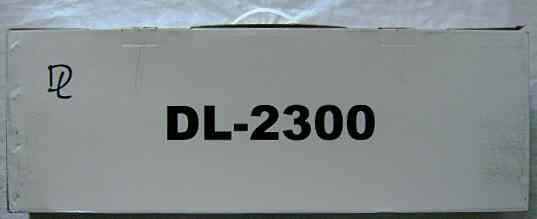 |
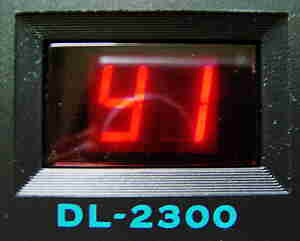 |
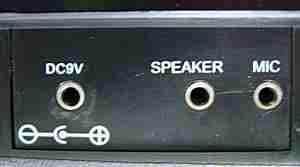 |
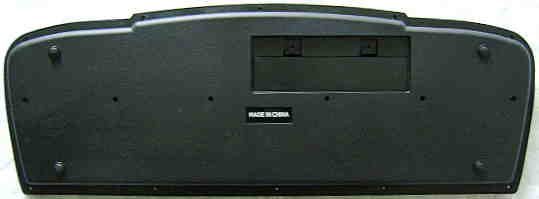
|
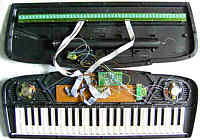 |
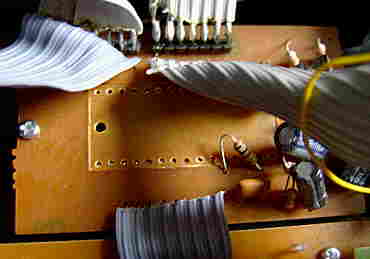
 |
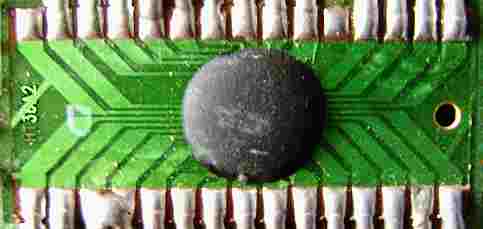 |
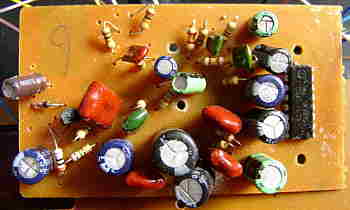 |
 |
The sample quality is fairly high and sounds astonishingly clear for such a poorly designed tablehooter; most sample based cheap keyboards with COB cpu (Sankai, Yongmei etc.) distort much more. Especially "trumpet" and "vibes" are very natural. But the preset sound set differs from the list on the control panel and contains many doublets those often have nothing common with their names. Due to most samples employ no split zones, the bass range of many sounds is unrealistic; e.g. some wind instruments grunt with very slow attack by the too slow sample playback frequency. None of the sounds contain vibrato or tremolo. In the following I will only explain sounds those are special or differ in their normal pitch range from what their name suggests. Doublets are listed separately and all sounds are named here by their lowest number. The "piano" has 5 key split zones and a fairly natural timbre, although the bass range is thin, which may also have to do with low sample resolution. "vibes" contains no own vibrato. "flute" is a metal flute with breathy wind noise during attack, which growls strangely in the bass range. "pipe organ" is a metal pipe organ rank. "oboe" has 2 key split zones. "guitar" is an acoustic one; "bass" a picked bass guitar. "e.piano" resembles a rhodes with high notes, but mids and bass range are rather like a dull clavinet or guitar; it is slightly distorted, semi- metallic and notes stop immediately after key release; held notes decay very slow. "harpsichord" has a rumbling mechanical attack noise. "bell" is a musicbox sample with clicking attack. "panflute" sounds like a recorder flute. "synth" is a narrow squarewave or sawtooth wave that fades a little quieter after its percussive attack (sounds like from C64). "organ" is a Hammond timbre with percussive attack and semi- hollow bass range. "clarinet" sounds reedy and more like a bass clarinet or oboe and grows quieter at the beginning. "brass" sounds like a low resolution FM synth brass sample with duller growing attack. Later it loops in a static tooting timbre and slowly decays; the bass range grunts interesting. "accordion" has a too dull and hollow bass range. "e.bass" is a dull one.
doublets (identical sounds):
| 00 | piano | = bright acoustic piano, kalimba, jazz piano, clean guitar | |
| 01 | banjo | = koto, xylophone, shamisen, pipa | |
| 02 | vibes | = dulcimer, music box, tinkle bell, sitar | |
| 03 | flute | = french horn, recorder, clarinet (#64), long flute | |
| 04 | violin | = electric volion, overdriven guitar, viola, synth strings | |
| 05 | pipe organ | = hammond organ, tango accordian, percussive organ, jazz organ | |
| 06 | oboe | = tenor sax, bagpipe, baritone sax, square | |
| 07 | trumpet | = tuba, trumpet (#51), brass section, muted horn | |
| 08 | guitar | = acoustic guitar, fretless bass, jazz guitar, muted guitar | |
| 09 | bass | = hawai guitar, honky-tonk piano, acoustic bass, spain guitar | |
| 10 | e. piano | = nylon guitar, clavichord, slap bass, steel guitar | |
| 11 | harpsichord | = distortion guitar, harp piano, guitar all, guitar harmonics | |
| 12 | bell | = celesta, vibraphone, crystal, rain | |
| 13 | panflute | = piccolo, english horn, ocarina, scotland bagpipe | |
| 14 | synth | = chorused piano, clav, bottle blow, metallic | |
| 15 | organ | = reed organ, rhodes piano, harpsichord (#66), 60's organ | |
| 16 | clarinet | = alto sax, bason, new age, synth voice | |
| 17 | brass | = synth bass 1, finger bass, warm31 koto, echoes | |
| 18 | accordion | = bassoon, trombone, fiddle, tremolo strings | |
| 19 | e.bass | = bass (#21), pick bass, synth bass 2, e.bass |
The sustain button adds a long 3.5s sustain to all preset sounds. The vibrato button adds a weak 6Hz vibrato. Both also affect bass and chord voice in accompaniments. Unlike vibrato and sustain, selecting a new preset sound does not affect held notes.
The percussion samples sound clear although a bit thin.
The 6 drumpad buttons show wrong icons; instead of {hihat, shaker, snare,
hand clap, low conga, high conga} they play {open hihat, closed
hihat, base, snare, low conga, high conga}. The "congas" decay quite long
and may be also some kind of synth toms. Also the "open highhat" has a
long and fairly thin sample. The "snare" bangs loud. The custom drummer
works similar like with Letron MC-3, but
the user pattern is deleted when any normal rhythm is started (with "start")
or notes are recorded into the sequencer. To program a rhythm, press "program",
enter percussion with the drumpads (only monophonic) or pause steps with
any keyboard key (the here sounding notes are not recorded) and press "program"
again to finish, or "backplay" ("play" does the same) to start the custom
pattern immediately. Press "stop" to stop it. With accompaniment the chord
pattern from the currently selected rhythm is used. (You can still select
a different one. Fill-in doesn't work here.)
| 00: 30, 49, 76, 84
01: 31, 47, 68, 99 02: 27, 45, 72, 90 03: 22, 53, 64, 87 04: 25, 44, 73, 89 05: 29, 43, 61, 82 06: 24, 50, 77, 93 07: 32, 51, 65, 81 08: 38, 59, 78, 95 09: 28, 46, 62, 97 10: 20, 55, 60, 96 11: 34, 54, 63, 85 12: 23, 56, 74, 92 13: 39, 42, 69, 86 14: 33, 57, 67, 91 15: 37, 41, 66, 98 16: 35, 58, 79, 83 17: 26, 40, 70, 88 18: 36, 48, 75, 80 19: 21, 52, 71, 94 |
The 20 rhythms are always completely mapped into any next following block of 20 rhythm numbers, but the permutation within each block changes. The identical 20 to 100 mapping pattern is also used for the 20 preset sounds. |
The chord voice of manual chord and accompaniment always employ the "synth" timbre (a narrow squarewave or sawtooth wave that fades a little quieter after its percussive attack, sounds like C64). The bass voice in manual bass or accompaniments is always "bass" (a dull e-bass). The manual bass can be even played polyphonic (like a key split) and shares its polyphony channels with the main voice. The accompaniment volume buttons do not affect held chord or manual bass notes. The automatic accompaniment sounds lovely anachronistic like an early 1980th home keyboard; like the archaic Antonelli Star 2379 the patterns only chop the whole played chord into a staccato and never strum or separate its notes from each other. During fill-in the accompaniment pattern continues. Unfortunately there is no separate rhythm volume control, but you can program a blank user pattern if you only want the accompaniment. (Together with a "panflute" this can sound so incredible cheesy and innocent - I love it.) When preset rhythm is running, any newly selected rhythm is played immediately without restarting the pattern, which can be used like a fill-in by stepping through the rhythm list back and forward with the +/- buttons.
The demo melodies employ a monophonic main voice with changing preset sounds and standard accompaniments.
The 8 demo melodies are:
The demo songs are also used by the 2 play training functions. "teaching A" is one key play (any key advances the melody step by step). "teaching B" behaves similar, but wrong played notes play in a low "brass" sound instead of the normal main voice sound of that song. (The manual falsely claims it would ignore wrong notes until the right key is pressed.)
A variant of this instrument with cyan coloured case and black control
panel (drumpad buttons have more icons around, the center one is white)
was released as Yongmei YM-2300, which according to its sound list
layout seems to contain Yongmei YM-2100
hardware. The same case in black was also used for the Yongmei YM-2200
(only 12 preset sounds, 10 rhythms, grey control panel - all seen on the
Yongmei
site).
| removal of these screws voids warranty... | ||
 |
||
|
|